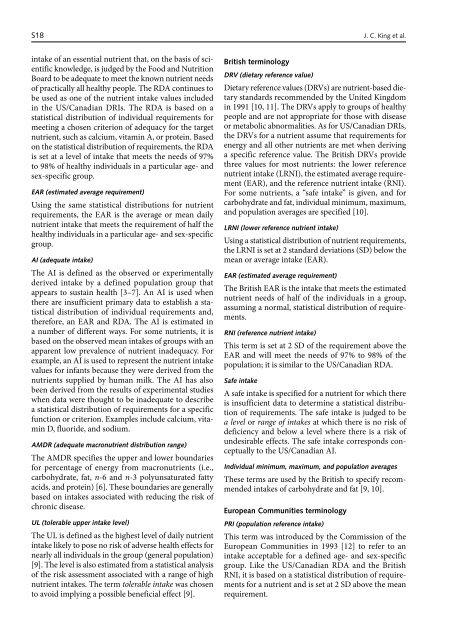Implementing food-based dietary guidelines for - United Nations ...
Implementing food-based dietary guidelines for - United Nations ...
Implementing food-based dietary guidelines for - United Nations ...
Create successful ePaper yourself
Turn your PDF publications into a flip-book with our unique Google optimized e-Paper software.
S18<br />
intake of an essential nutrient that, on the basis of scientific<br />
knowledge, is judged by the Food and Nutrition<br />
Board to be adequate to meet the known nutrient needs<br />
of practically all healthy people. The RDA continues to<br />
be used as one of the nutrient intake values included<br />
in the US/Canadian DRIs. The RDA is <strong>based</strong> on a<br />
statistical distribution of individual requirements <strong>for</strong><br />
meeting a chosen criterion of adequacy <strong>for</strong> the target<br />
nutrient, such as calcium, vitamin A, or protein. Based<br />
on the statistical distribution of requirements, the RDA<br />
is set at a level of intake that meets the needs of 97%<br />
to 98% of healthy individuals in a particular age- and<br />
sex-specific group.<br />
EAR (estimated average requirement)<br />
Using the same statistical distributions <strong>for</strong> nutrient<br />
requirements, the EAR is the average or mean daily<br />
nutrient intake that meets the requirement of half the<br />
healthy individuals in a particular age- and sex-specific<br />
group.<br />
AI (adequate intake)<br />
The AI is defined as the observed or experimentally<br />
derived intake by a defined population group that<br />
appears to sustain health [3–7]. An AI is used when<br />
there are insufficient primary data to establish a statistical<br />
distribution of individual requirements and,<br />
there<strong>for</strong>e, an EAR and RDA. The AI is estimated in<br />
a number of different ways. For some nutrients, it is<br />
<strong>based</strong> on the observed mean intakes of groups with an<br />
apparent low prevalence of nutrient inadequacy. For<br />
example, an AI is used to represent the nutrient intake<br />
values <strong>for</strong> infants because they were derived from the<br />
nutrients supplied by human milk. The AI has also<br />
been derived from the results of experimental studies<br />
when data were thought to be inadequate to describe<br />
a statistical distribution of requirements <strong>for</strong> a specific<br />
function or criterion. Examples include calcium, vitamin<br />
D, fluoride, and sodium.<br />
AMDR (adequate macronutrient distribution range)<br />
The AMDR specifies the upper and lower boundaries<br />
<strong>for</strong> percentage of energy from macronutrients (i.e.,<br />
carbohydrate, fat, n-6 and n-3 polyunsaturated fatty<br />
acids, and protein) [6]. These boundaries are generally<br />
<strong>based</strong> on intakes associated with reducing the risk of<br />
chronic disease.<br />
UL (tolerable upper intake level)<br />
The UL is defined as the highest level of daily nutrient<br />
intake likely to pose no risk of adverse health effects <strong>for</strong><br />
nearly all individuals in the group (general population)<br />
[9]. The level is also estimated from a statistical analysis<br />
of the risk assessment associated with a range of high<br />
nutrient intakes. The term tolerable intake was chosen<br />
to avoid implying a possible beneficial effect [9].<br />
British terminology<br />
DRV (<strong>dietary</strong> reference value)<br />
Dietary reference values (DRVs) are nutrient-<strong>based</strong> <strong>dietary</strong><br />
standards recommended by the <strong>United</strong> Kingdom<br />
in 1991 [10, 11]. The DRVs apply to groups of healthy<br />
people and are not appropriate <strong>for</strong> those with disease<br />
or metabolic abnormalities. As <strong>for</strong> US/Canadian DRIs,<br />
the DRVs <strong>for</strong> a nutrient assume that requirements <strong>for</strong><br />
energy and all other nutrients are met when deriving<br />
a specific reference value. The British DRVs provide<br />
three values <strong>for</strong> most nutrients: the lower reference<br />
nutrient intake (LRNI), the estimated average requirement<br />
(EAR), and the reference nutrient intake (RNI).<br />
For some nutrients, a “safe intake” is given, and <strong>for</strong><br />
carbohydrate and fat, individual minimum, maximum,<br />
and population averages are specified [10].<br />
LRNI (lower reference nutrient intake)<br />
Using a statistical distribution of nutrient requirements,<br />
the LRNI is set at 2 standard deviations (SD) below the<br />
mean or average intake (EAR).<br />
EAR (estimated average requirement)<br />
The British EAR is the intake that meets the estimated<br />
nutrient needs of half of the individuals in a group,<br />
assuming a normal, statistical distribution of requirements.<br />
RNI (reference nutrient intake)<br />
This term is set at 2 SD of the requirement above the<br />
EAR and will meet the needs of 97% to 98% of the<br />
population; it is similar to the US/Canadian RDA.<br />
Safe intake<br />
A safe intake is specified <strong>for</strong> a nutrient <strong>for</strong> which there<br />
is insufficient data to determine a statistical distribution<br />
of requirements. The safe intake is judged to be<br />
a level or range of intakes at which there is no risk of<br />
deficiency and below a level where there is a risk of<br />
undesirable effects. The safe intake corresponds conceptually<br />
to the US/Canadian AI.<br />
Individual minimum, maximum, and population averages<br />
These terms are used by the British to specify recommended<br />
intakes of carbohydrate and fat [9, 10].<br />
European Communities terminology<br />
PRI (population reference intake)<br />
J. C. King et al.<br />
This term was introduced by the Commission of the<br />
European Communities in 1993 [12] to refer to an<br />
intake acceptable <strong>for</strong> a defined age- and sex-specific<br />
group. Like the US/Canadian RDA and the British<br />
RNI, it is <strong>based</strong> on a statistical distribution of requirements<br />
<strong>for</strong> a nutrient and is set at 2 SD above the mean<br />
requirement.




